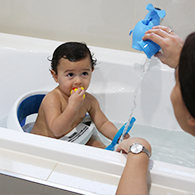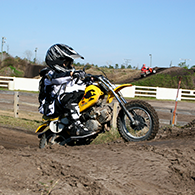Farm and Recreational Vehicles
Farm and recreational vehicles are typically 2 and 4 wheeled vehicles such as motorbikes, quad bikes and side-by-side vehicles. They are mainly used off-road and are only required to be registered if they will be used on gazetted roads. On farms, they are used for many tasks around the farm, while recreational use includes guided tours as well as unsupervised riding on private land or other off-road places.
Quad bikes were originally introduced in the United States of America in 1970 for farm use. Since then, they have become increasingly popular worldwide for recreational activity as well as work vehicles on farms. Due to the popularity of quad bikes, manufacturers began producing smaller sized versions promoted as suitable for adolescents and younger children. These child and youth sized quad bikes can still travel at speeds of up to 60kph and can weigh up to 120kg.
Quad bikes are one of the leading causes of accidental fatalities and injury in rural Australia and are associated with a number of Emergency Department presentations, hospital admissions and several deaths in children under the age of 16 years.
According to the Australian Competition and Consumer Commission, between 2011 and 2019 there were 136 quad bike-related deaths in Australia, of which 15% involved children. Approximately, six people require hospital treatment each day as a result of quad biking injuries.
Quad bikes are often called All Terrain Vehicles (ATVs). This is misleading as they are prone to tipping and rolling-over when moving at speed or across uneven ground. Approximately 60% of quad bike deaths are due to rollover. Additionally, 40% of quad bike related injuries are traumatic head injuries.
Common user risk factors for injuries and deaths on quad bikes include rider inexperience, lack of appropriate personal protective equipment and hazardous driving.
While there is currently no legislation mandating a minimum age for quad bike use, injury prevention researchers, surgeons and safety agencies strongly recommend that children less than 16 years of age do not use quad bikes, in particular adult size quad bikes. A number of studies have found that children lack the physical and cognitive capacity to control and operate quad bikes safely as they do not yet have the skills to judge speed, distance and make critical lifesaving decisions. Quad bikes are heavy (up to 400kg) and can be difficult to control at speed and are at risk of rolling over on uneven ground.
In October 2019, after extensive consultation, the Australian Competition and Consumer Commission, introduced a new mandatory product safety standard for quad bikes. The standard requires that there be improved consumer information for quad bike purchasers and that manufacturers improve the design of quad bikes for better lateral stability and rollover protection for users. Child and youth quad bike models are not covered by the product safety standard.
Detailed information can be found by following this link Consumer Goods (Quad Bikes) Safety Standard 2019
Key points:
- Children less than 16 years and under should not use quad bikes.
- SSV and 2 wheeled motor bikes are a better alternative.
- Wearing appropriate personal protective equipment, such as seat belts and helmets helps to prevent or reduce the severity of injury and death.
- Children and young people using motorbikes, SSV or youth model quad bikes still need to be supervised at all times
- Only buy quad bikes that comply with the new mandatory product safety standard.
The following videos explain why children under 16 should not use adult size quad bikes.
The video below from SafeWork NSW presents research on quad bike safety and how dangerous they can be.
Motorcycles
In 2009, a symposium was held to explore ways in which off-road motorcycle injuries to children can be prevented. It brought together industry representatives, injury and medical professionals, and members of the general public. The downloads section includes links to the program and presentations of the evening which may be relevant to those interested in the prevention of child injury, particularly from off-road motorcycle use.








